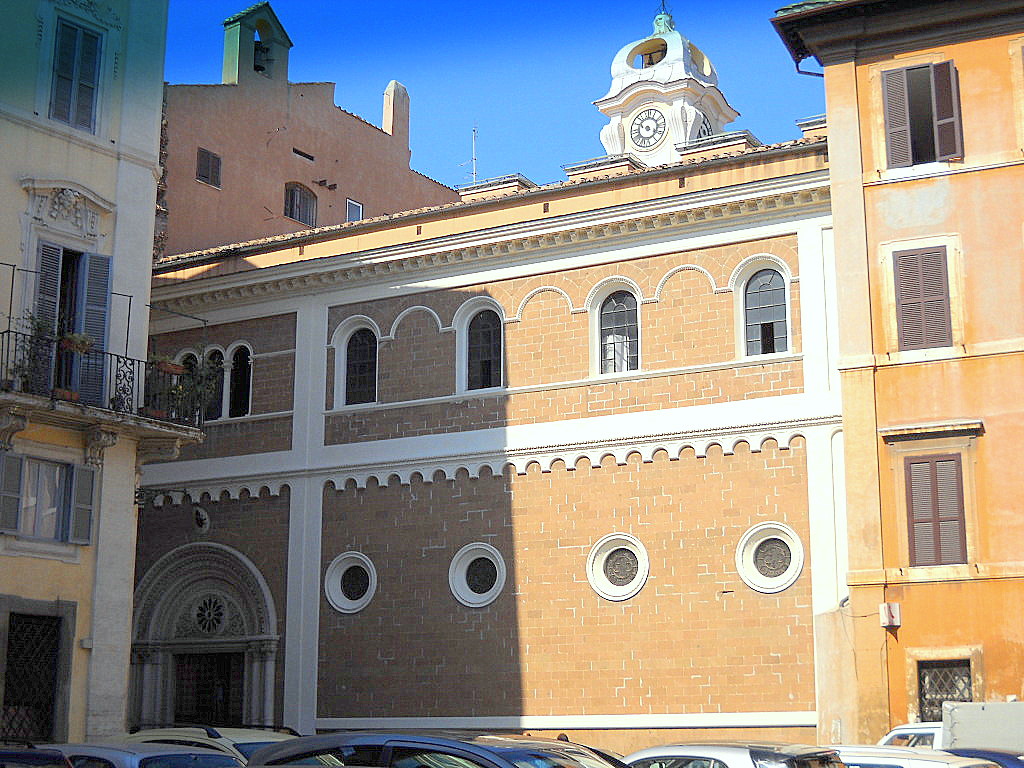Church of St Thomas of Canterbury

There are at least three churches that have followed one another over the centuries on the same site as the current Church of St. Thomas of Canterbury which is located within the Venerable English College.
The earliest known church is the Church of the Holy Trinity of the Scots, which an undocumented tradition attributes to the will of the king of Mercia Offa in 630.
It is attested, with annexed a monastery and a hospice for the pilgrims of England, at the end of the XII century in the catalog of Cencio Camerario at nº 56 with the title of sancte Trinitati Scottorum. A bull of Pope Boniface VIII of 1299, which confirms a precedent of Pope Innocent IV (1249), attributes the church to the monastery of San Gregorio al Celio.

The institution of the Jubilees was accompanied by the increase in the number of pilgrims from across the Channel. This led to the birth of a societas pauperorum Anglorum (which later became a brotherhood) and the expansion of the hospice in via di Monserrato and the adjoining church, rebuilt in 1363. It was in this period that the ancient title was added to that of St. Thomas Becket, Archbishop of Canterbury in the 12th century. The building underwent an initial restoration and expansion in 1450.
Starting with Henry VII (1485-1509), it was the English sovereign who had the task of appointing the rector of the church and the hospice; but after the schism of Henry VIII, Pope Paul III claimed this right from the church of Rome, and in 1538 Cardinal Reginald Pole was appointed governor of the church and of the annexed buildings.
In 1575, on the initiative of Cardinal William Allen, a work was undertaken to rebuild the church and the old hospice. With a bull of Pope Gregory XIII of 1 May 1579, the hospice was changed into an ecclesiastical college for young students of the English nation, today's Venerable English College, entrusted to the Jesuits. Personalities from the Anglo-Saxon world were guests in the college, including Thomas Cromwell, Earl of Essex, in 1514, Cardinal Reginald Pole in 1534, the poet John Milton in 1636. Between 1581 and 1584 Niccolò Circignani, known as Pomarancio, frescoed the library walls above the church, with stories of English saints and martyrs.
In the Temporal State of the Churches of Rome of 1661 the sacred building is described as follows:
«The church is dedicated to the Holy Trinity and to Tommaso Cantuariense. It has a bell tower with three bells and a clock. It has five altars and two common burials, it is suffixed and above it there is the library of the College. It has annexed the care of the souls of schoolchildren and other servants which is exercised by the father Rector. It has four courtyards and in one there is a large new well. Item has a garden with a division of myrtle and several dawns of merangoli and citrus espaliers. "
(Armellini, op.cit.)
Between 1680 and 1685, Cardinal Thomas Howard had the church and college restored; on this occasion the Borrominian-inspired clock tower was added.
With the French occupation of Rome, the complex was transformed into a barracks. Only in 1818 did it return to its former use, but it needed a general restoration. The church was the subject of a radical restoration: the first stone was laid on February 6, 1866 and the new building was reopened for worship in 1888. Three architects followed the direction of the works: Luigi Poletti, Pietro Camporese the Younger and, from 1873, Virginio Vespignani; the quadrangular apse was demolished, replaced by a flat bottom wall, and a new facade was built on Via di Monserrato, in neo-medieval style.
Two altarpieces in the minor aisles - an Immaculate Conception and an Apparition of the Sacred Heart to Anna Maria Javouhey - were painted by Silverio Capparoni.
Map: Church of St Thomas of Canterbury
Address: Via di Monserrato, 45, 00186
Roma (RM) Lazio
Latitude: 41.89559697825804
Longitude: 12.470051050186157
Site: ...
vCard created by: CHO.earth
Currently owned by: CHO.earth
Type: Building
Function: Church
Creation date: 25-04-2022 04:05
Last update: 04/05/2022